The Norwegian Coin Became Hernock Again
History of Norges Banking company
Norges Banking concern'southward history began in 1816, but Norway's numismatic history dates back roughly to the twelvemonth 1000.
C. one thousand
The showtime known Norwegian coin is a penny attributed to Olav Tryggvason, around the twelvemonth 1000. Minting of coins was a purple monopoly. For long periods no coins were minted in Norway, and monetary needs were and so satisfied through import of strange coins.
1628
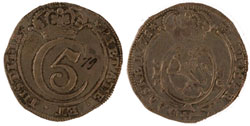 |
| 4 mark, 1678 |
A mint was established in Christiania (now Oslo), using silver from the mines and works at Kongsberg. Equally a memento of that era we yet have Myntgaten (Mint Street) in Oslo, c. 100 metres from the site of the imperial mint.
1686
Coin production was moved to Kongsberg, where the Mint of Norway (Det Norske Myntverket) is still located, Nybrofossen.
1695
The first Norwegian banknotes. King Christian Five granted the Bergen merchant Jørgen Thor Møhlen the correct to issue and pay with notes, which were supposed to be legal tender from the Åna-Sira valley (Flekkefjord) and north upwards the coast. The notes were meant to cover a transition catamenia before beingness redeemed in coin, but were met with distrust and demands for rapid redemption. Møhlen could not meet the demands and went bankrupt.
1736
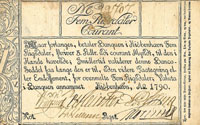 |
| five Rigsdaler Courant, 1790 |
The first issuing banking company in Denmark-Norway was established: the Assignations-, Vexel- og Laanebanken - also called the Courantbanken (after the name of the current coin of the realm, Rigsdaler Dansk Courant). It was a individual depository financial institution, but discipline to royal regulation. Apart from issuing notes, information technology also lent money to the government. There was, even so, no restriction on the quantity of notes issued, and far likewise many were put into apportionment. In 1745 the bank had to abandon redemption in silver, and the value of the notes fell. That the country took over the bank in 1773 and connected using it to finance the Treasury was not a great help.
1791 and 1799
In lodge to make clean up the monetary system, in 1791 a new issuing bank was founded, Den Danske og Norske Speciebank, with regulations that were ahead of their time - and 3 branches in Norway. The regulations did not help, even so, equally the regime used this bank besides to finance its expenditure. In 1799 it was replaced by the Deposito-Cassen, only the same policy continued.
1813
"The land bank collapse" is what the Danes still call the events in connection with the foundation of the Rigsbanken equally a new issuing banking concern on 5 January 1813, in order to put Danmark'south monetary firm in order. For simultaneously with the establishment of the bank, the currency was sharply depreciated. The Rigsbanken, too, was used to finance the authorities.
Norway was now equally good every bit separated from Kingdom of denmark, nether Prince Christian Frederick as viceroy. In that location were bad harvests, and the state was brusque of coin. To raise revenues he issued his ain currency, the so-called "Prince'south Notes", to supplement the notes from the Rigsbanken branch in Christiania. Later Norway passed nether Swedish control in autumn 1814, Carl Johan (Align Bernadotte) of Sweden regarded them equally false, and alleged that possessors of such notes would exist treated as counterfeiters. For a while the Courantbanken'south notes, the Assignation certificates, the Treasury certificates, the Rigsbanken'southward notes and the Prince'south Notes all circulated together, to general confusion.
1814
After a fierce debate, the Norwegian Constituent Associates of spring 1814 passed the so-called "Eidsvold Guarantee" by 79 to 29: the Rigsbanken was to issue fourteen 1000000 rigsdalers in new notes - and the Assembly guaranteed the rate personally. Minister Carsten Tank called the decision a national catastrophe and resigned. He was proved right: the guarantee was a cleaved reed. But in the light of the feel of the issuing banks described above, information technology was inappreciably strange that the framers of the Constitution emphasised that a hereafter Norwegian banking company "should not advance monies to the State", that is, not lend to the government.
1816
Two years after the separation from Denmark and the union with Sweden, Norges Bank was established past Act of the Storting (the Norwegian parliament) of fourteen June 1816. This beak followed work in several committees that replaced one another. The monetary unit was to exist the speciedaler (rixdollar), divided into 120 skillings or 5 ort ("rigsort") of 24 skillings each.
The banking company's silver fund of 2 million rixdollars was in principle to be obtained by voluntary subscription, just this was a huge fiasco. Over the subsequent years, therefore, the fund had to exist financed by compulsory levies of coin or noble metals - the so-called "silver tax". Share certificates were issued for the contributions. The Storting had resolved that the headquarters would be located in Christiania if the silvery fund could be created by voluntary subscription - if non, it would be sited in Trondheim with commune offices in Christiania, Bergen and Kristiansand.
1817
The latter turned out to be the case. The functioning started upward in pocket-size, leased premises in the Stiftsgaarden, Trondheim'south erstwhile gubernatorial residence, in Jan 1817. Opening hours were i hour every solar day for exchange of notes, two hours for disbursement of loans and dividend on the shares. One of the 5 members of the Board of Directors was to exist present two hours a day. The Lath met twice a calendar week, chaired by the most senior member; not until 1983 was there a permanent chairman. Virtually of the depository financial institution'due south management were immigrants or the sons of immigrants from Denmark or the German states. The first year the notes were printed in Christiania and transported to Trondheim for numbering and signing, a journey of 12 days.
1818
The rixdollar note was supposed to represent to "ane Cologne mark of fine silver", that is, 233.85 grams, and to be freely redeemable for silver in 1819. In the menstruum after the establishment of Norges Banking company, however, the dollar fell in value, and by Act of thirteen August 1818, the right of redemption was suspended. The rate fell farther after that.
1823
On November 15, 1822 the Storting resolved that silver redemption at rates beneath the previously decided par value should begin from January 1, 1823. An interval for silver redemption was fixed, which was gradually adjusted nearer par until 1842.
1842
The rixdollar was finally pegged to silver at par in April 1842.
1874
In the Money Human activity that became law on 4 June 1873, the Storting decided to go onto the gilt standard and to use the terms krone and øre in parallel with daler and skilling, 1 rixdollar equal to four kroner. The silver was replaced by the gold standard from one January 1874. The gilded standard had been recommended past an international money conference in Paris in 1867, in which Norway also participated. The intention was partly to achieve a more than stable money value - golden was regarded equally more solid than silver - and partly to accomplish an international system based on fixed exchange rates vis-à-vis gilt.
Under both the silver and gold standards the right to redeem notes for metal was suspended for long periods. The right was abolished forever in 1931.
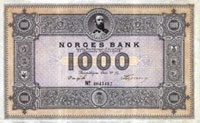 |
| 1000 kroner banknote, 1877-1901 |
1875
The Money Human action of 17 April 1875 discontinued the terms daler and skilling, and it was decided that "The budgetary unit shall be a krone, divided into 100 øre." This was done to prepare for Norway's entry, on 16 Oct that year, into the Scandinavian Mint Union. This union had been established between Kingdom of denmark and Sweden in 1873 on the recommendation of a joint commission (in which Norway participated) to found a common Scandinavian coin based on gold. It meant that the other countries' coins were to be legal tender on the aforementioned ground as those struck at dwelling house. The union functioned until 1914; thereafter it lacked all applied significance, but was not formally abolished until 1972.
1892
A new law governing Norges Bank became law on 23 April 1892.
1897, 1906
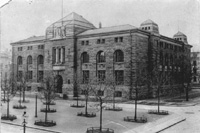 |
| Bankplassen 4, Norges Bank's offices 1906-1986. |
On 1 January 1897 the seat of Norges Depository financial institution was moved to Kristiania (Oslo), and in 1906 a new headquarters building on Bankplassen was opened - for 80 employees including the workers in the banknote printing institute.
1914-eighteen
The duty to redeem for aureate was suspended on five August 1914 and the krone floated. Consign of gilt and silverish was prohibited. During the war the book of notes increased fourfold, but the krone yet appreciated - in upshot of the sharp rise in revenues generated by the merchant marine. Golden redemption was reintroduced in 1916, only considering the notes were now worth more than the official gilded rate, in April 1916 the banking concern was exempted from the duty to purchase in gold for the notes.
1920
Gilded redemption was suspended yet again on 19 March 1920. Aggrandizement and a loftier volume of imports led to a crisis of confidence in the krone and a precipitous fall in its value. The "par policy" led to a rise in the rate, and by 1926 the krone was par with the pound sterling.
1928
The krone was pegged to gold at par on 1 May and gilded redemption reintroduced.
1931
On 27 September the golden standard was abolished, after the United kingdom of great britain and northern ireland had left it vii days before. Norway and the other Nordic countries followed suit and let their currencies float, but were determined to prevent harmful fluctuations.
 |
| Banknote production, 1930 |
1933
A fixed rate vis-à-vis the pound of NOK 19.90 was adopted.
1939
The exchange rate is fixed in relation to the dollar, at NOK four.40. Since the dollar was tied to gold, this brought Norway back onto the gold standard.
1940-45
In 1940 the seat of Norges Bank was temporarily moved to London, in that the Norwegian government-in-exile established a new Board. The bank'due south gold reserves were evacuated via Åndalsnes, Molde and Tromsø to London, and thence to New York and Ottawa. This gilded and the bank's other currency reserves were nether the control of the London Board. The and then-called London krone was stock-still at NOK 17.lxx to the pound.
At the same time, the banking concern connected its operations in Norway under the management of the Occupying Ability until the state of war was over and the London Board stepped downwardly. A commission of inquiry afterward the state of war concluded that the Depository financial institution'due south Oslo direction had taken a house and right mental attitude vis-à-vis the Nazi authorities.
A currency reform was implemented on viii - 22 September 1945 to dispose of excessive notes in circulation and thereby prevent inflation.
1946
Norway joined the Bretton Woods organisation of fixed substitution rates from fifteen September 1946. The par value vis-à-vis gold represented a rate of NOK twenty.00 to the pound and NOK 4.03 to the dollar. The maximum permitted fluctuation was ane per cent.
1949
Up to 1949, Norges Depository financial institution was formally organised equally a company limited by shares. By Deed of 8 July 1949 private shareholders were bought out and the shares taken over by various state funds.
The pound sterling was devalued by xxx.5 per cent, and similar several other European countries, Norway followed suit. The new cadre rate vis-à-vis the dollar was NOK vii.14.
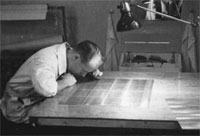 |
| Quality command of banknotes, 1955 |
1962
The Mint Supervisory Authorization and the Royal Mint were transferred from the state to Norges Banking company.
1971
The Bretton Forest treaty arrangement of stock-still exchange rates bankrupt downward on 15 August, and the Norwegian krone floated. On 21 December a new system was created, the Smithsonian Treaty, with new parities and fluctuation margins of 2.25 per cent. The Norwegian (and Swedish and Danish) krone was devalued by 1 per cent.
1972
On 23 May Norway joined the "European snake", in which the fluctuation margin was half of that laid down in the Smithsonian Treaty. At that place was thus a narrow margin of fluctuation inside a larger, and the combination was called "the snake in the tunnel".
1973
The Smithsonian Treaty collapsed, only the European serpent continued. This meant that the krone floated vis-à-vis currencies outside the snake, such as the dollar. The krone was revalued by 5 per cent within the serpent on 16 November.
1976-78
On ten October 1976 the krone was devalued by 1 per cent, on four April 1977 by 5 per cent, and 29 August 1977 by 8 per cent. The reason for this was unlike trends in prices and wages in the countries of the ophidian, and adjustments were mostly made for several countries at the same time.
On 12 Dec 1978 Norway left the serpent and instead linked the krone to a "basket" of currencies, which were weighted co-ordinate to the various countries' merchandise with Norway.
1982-86
On 2 August 1982 the weightings of the currency handbasket were inverse in accordance with the Imf's weightings for export industry competitiveness, which meant a downwards adjustment of 3.v per cent. On half-dozen September 1982 the krone was devalued past vi per cent.
On 2 July 1984 the currency handbasket was calculated on a geometric average instead an arithmetic, which meant a 2 per cent devaluation, and on 22 September it was decided to go on the krone 2 per cent weaker within the applicative fluctuation margin.
1985
A new Act of 24 May 1985 on Norges Depository financial institution and the monetary system etc. (the Norges Bank Act) entered into forcefulness on 9 September 1985. The banking company ceased to be a limited company and became a split up legal entity owned past the state.
1986
 |
| Bankplassen 2, Norges Depository financial institution's |
On 11 May the krone was devalued by 9.ii per cent.
On 1 September 1986 Norges Bank'south headquarters and banknote printing plant moved to a new edifice at Bankplassen in Oslo.
1988
The Storting decided to close eight of Norges Bank's 20 regional branches, those in Arendal, Drammen, Gjøvik, Halden, Hamar, Haugesund, Kristiansund Northward. and Skien.
1990
The krone is pegged to the Ecu - the European Currency Unit of measurement, the precursor of the Euro.
1992
Following turbulence on the international currency markets in November and December, the link to the Ecu was abandoned on 12 Dec and the krone floated. The same had happened to the Swedish krona, the Finnish markka, the pound sterling and the lira earlier in the autumn.
1994
Guidelines for the floating commutation charge per unit regime were issued on v May in government regulations on the krone's exchange rate.
1997
Norges Bank was entrusted with the management of the Government Petroleum Fund.
A new settlement arrangement between Norges Bank and the banks was commissioned. Norges Depository financial institution's settlement system (NBO) means settlement several times a twenty-four hour period, with a facility for separate settlement of big sums. This was a footstep towards greater security and reliability in payments transfer.
1998
The replacement of the coin series was completed, the first complete replacement since 1875.
2000
The Act relating to Payment Systems, etc., enters into force. The Human activity introduces authorisation and supervision of payment systems and assigns these responsibilities to Norges Bank.
Den Kongelige Mynt (the Royal Mint) in Kongsberg is spun off as a split up limited company as of 1 January.
Norges Bank's Supervisory Council decides to close the regional branches in Bodø, Fredrikstad, Hammerfest, Vardø and Ålesund.
Norges Bank establishes an office in London to further develop the Banking concern's investment management activities.
2001
The new Regulation on Budgetary Policy was established past the Council of State on 29 March 2001. Norges Bank shall ready the central rate with a view to maintaining low and stable inflation. The aggrandizement target is set at 2½ per cent.
Together with other banks, Norges Bank establishes Norsk Kontantservice AS (NOKAS) on one July. The company will be responsible for greenbacks treatment for banks in Norway as well as for some of Norges Bank's statutory responsibilities in the area of cash handling. At the same time, Norges Banking concern's remaining regional offices are closed.
2003
Den Kongelige Mynt As (the Royal Mint) is sold to Samlerhuset Every bit Norge and Mint of Republic of finland. The shares are transferred to the new owners on 30 June.
2005
An agreement concerning the sale of Norges Bank's shares in NOKAS is signed with Hafslund Sikkerhet As on 9 Dec. The shares are transferred to the new owners on vi January 2006.
2007
Norges Bank's Printing Works was closed down in June 2007 in accord with a determination taken by the Executive Board in 2002. From 2008, Norwegian banknotes will be delivered by commercial security printers in French republic and the UK. Read more about the history of Norges Bank's Press Works.
In November the Shanghai part of Norges Bank Investment Management (NBIM) was officially opened.
2010
In June the Singapore office of Norges Bank Investment Management (NBIM) was opened.
Source: https://www.norges-bank.no/en/topics/about/History/history-of-norges-bank/
Post a Comment for "The Norwegian Coin Became Hernock Again"